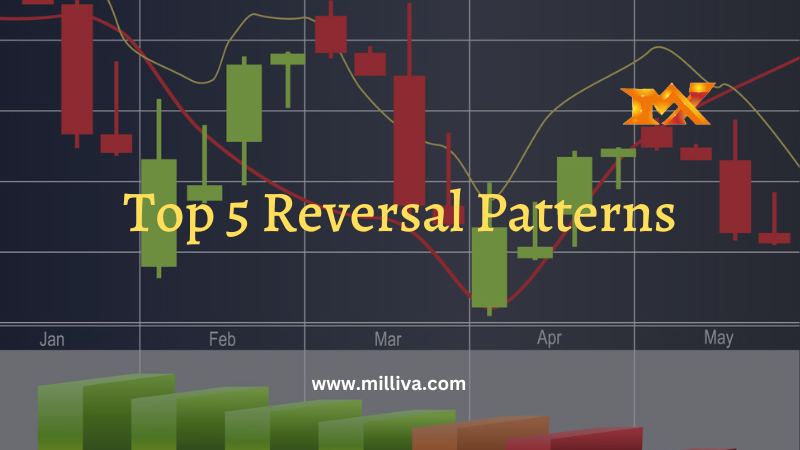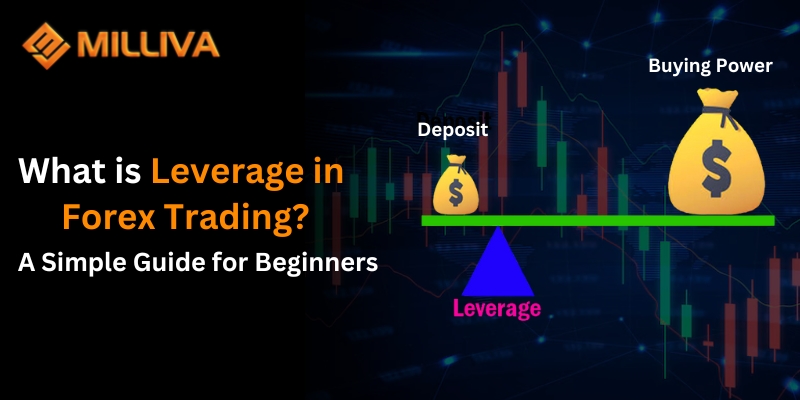Every Trader Must Understand These Five Strong Reversal Patterns

![]()
Five potent and dependable reversal patterns in the forex market will be covered in this article. Reversal patterns typically offer a high potential Risk-Reward ratio. Each of them will be recognised, and we’ll learn how to trade using these patterns.
What Are They Reversal Patterns?
When a market reverses direction from rising to falling, it is said to be in a reversal pattern. This pattern can be used to forecast future movement and decide when to initiate or end deals. Pattern for Head & Shoulders. A extremely distinctive reversal pattern is the Head & Shoulders pattern. It is a chart formation made up of three price peaks. The middle peak is usually the highest, with the two peaks on the sides being equal in height or close.
One of the most potent reversal patterns in the forex market is the Head and Shoulders pattern. The reason why this pattern was given its name is because it genuinely resembles a head with two shoulders on either side. This pattern is typically used following a large rise or the opposite Head & Shoulders pattern following a downtrend. In a bullish trend, the price forms the left shoulder at the top. The head will then form when, following a technical correction, the price establishes a higher peak. The price will now undergo a significant technical adjustment to reach the previous low.
Finally, the price generates the right shoulder, a lower high. The Neckline is the path that connects all three of the peaks’ base lines. After the price breaks the neckline, the pattern is confirmed. Following a downtrend, it is time to seek for a sell position or a buy position in the opposite Head & Shoulders at the moment the price breaks the neckline, which is seen as a reversal signal.
Two Tops and Bottoms
Both the double top and double bottom are patterns of reversal. A big increase is frequently followed by the double-top pattern, which might be helpful. Price always establishes higher peaks and lower lows during an upswing.
Two peaks that are the same height together make up the double-top motif. After an uptrend, the occurrence of two peaks at the same heights signifies that the buyers’ might is waning. The trigger line is the final bottom between the two tops. Only when the price breaks through the trigger line will the pattern be finished. We should consider a price action setup for the sell position when the price crosses the trigger line.
The double top pattern is exactly what the double bottom pattern is not. After a substantial price decline, it will typically be dependable and helpful. The price establishes lower tops and bottoms during a downturn.
In the double bottom pattern, the price establishes two bottoms at the same level, and the sellers were unable to establish a second, lower bottom. That suggests the sellers are losing ground, and a reversal opportunity could materialise soon. When the price crosses through the trigger line, which is the final top between the two bottoms, the pattern will be complete.

Quasimodo Design
One of the most effective and accurate chart patterns for spotting reversal possibilities is Quasimodo. The Quasimodo pattern is a relatively recent one among forex traders that use technical analysis. Similar to the other stated patterns, Quasimodo is more dependable and potent if it follows a notable uptrend or downtrend.
The Quasimodo pattern has a very basic construction. Price develops higher peaks and lower lows during an uptrend. The price then dropped from the previous peak to create a new lower low. A fresh lower bottom signals a shift in momentum from bullish to negative. The last price high will typically be the entry level.
Lower lows and lower peaks are created during a downtrend. The price then rises from the previous low and establishes a new higher high. This fresh higher high, which followed a few lower highs, shows that the momentum has shifted from negative to bullish. In that scenario, the previous bottom from which the price has rallied will serve as the entry level. The Quasimodo pattern offers excellent risk-reward potential, making it a superb pattern to trade. Candlestick Reversal Pattern with Engulfing.
Reversal Patterns
Two candles come together to produce the engulfing candlestick pattern, which is a reversal pattern. After a decline, bullish reversal patterns appear. They begin with a single bearish candle, which is followed by a sizable bullish candle that is engulfing the bearish candle. The bullish engulfing candle must finish above the high of the preceding candle. As a result, we should search for a price action setup for the buy position. This suggests that the buyers are starting to wake up.
After an uptrend, a bearish engulfing candlestick pattern will appear; in this formation, the first candle is a bullish candle, and the second is a bearish candle that is engulfing the bullish one. The bearish engulfing candle must finish below the low of the preceding candle. When this formation appears, we ought to start looking for a setup in the price action for a sell position. It becomes considerably more potent and dependable when a bearish or bullish engulfing candlestick pattern is found at support/resistance levels.
The Pin Bar Candlestick
One type of candle creation is the Pin Bar candlestick pattern. Among forex traders, this candlestick chart pattern is regarded as a reversal pattern. It is regarded as one of the most effective and trustworthy candlestick patterns for trading (it can also show up as an inverted hammer).
A bullish pin bar’s structure begins at the bottom with a protracted tail known as a “wick.” A long lower shadow results from the tail being at least two thirds the size of the entire candle. Following that, there is a little body, which is the region between the open and closed prices, and in some cases, a short tail at the top.
Reversal Patterns
After a significant slump, this kind of structure suggests that a reversal opportunity is about to present itself. In that situation, we ought to start looking for a setup for the buy position in price action. A bearish pin bar has the exact opposite structure, beginning with a long tail at the top, followed by a short body and, in some cases, a little tail at the bottom.
When a substantial rally is followed by a bearish Pin Bar candlestick pattern, we should start looking for a price action setup for the sell position. Compared to momentum trading or continuation trading, reversal opportunities are less common. However, reversal patterns are often more trustworthy, and the Risk-Reward potential is higher because each reversal opportunity might occasionally be the start of a new trend, and what is better than being in a trend from the very beginning?
I discussed the five most potent reversal patterns in this piece, which, in my opinion, can assist any trader in obtaining a higher risk-to-reward ratio over the long term.

Visit Us On: www.milliva.com





